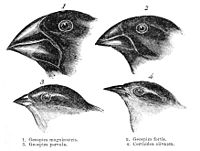
Photo from wikipedia
Populations with higher genetic diversity and larger effective sizes have greater evolutionary capacity (i.e., adaptive potential) to respond to ecological stressors. We are interested in how the variation captured in… Click to show full abstract
Populations with higher genetic diversity and larger effective sizes have greater evolutionary capacity (i.e., adaptive potential) to respond to ecological stressors. We are interested in how the variation captured in protein‐coding genes fluctuates relative to overall genomic diversity and whether smaller populations suffer greater costs due to their genetic load of deleterious mutations compared with larger populations. We analyzed individual whole‐genome sequences (N = 74) from three different populations of Montezuma quail (Cyrtonyx montezumae), a small ground‐dwelling bird that is sustainably harvested in some portions of its range but is of conservation concern elsewhere. Our historical demographic results indicate that Montezuma quail populations in the United States exhibit low levels of genomic diversity due in large part to long‐term declines in effective population sizes over nearly a million years. The smaller and more isolated Texas population is significantly more inbred than the large Arizona and the intermediate‐sized New Mexico populations we surveyed. The Texas gene pool has a significantly smaller proportion of strongly deleterious variants segregating in the population compared with the larger Arizona gene pool. Our results demonstrate that even in small populations, highly deleterious mutations are effectively purged and/or lost due to drift. However, we find that in small populations the realized genetic load is elevated because of inbreeding coupled with a higher frequency of slightly deleterious mutations that are manifested in homozygotes. Overall, our study illustrates how population genomics can be used to proactively assess both neutral and functional aspects of contemporary genetic diversity in a conservation framework while simultaneously considering deeper demographic histories.
Journal Title: Evolutionary Applications
Year Published: 2021
Link to full text (if available)
Share on Social Media: Sign Up to like & get
recommendations!